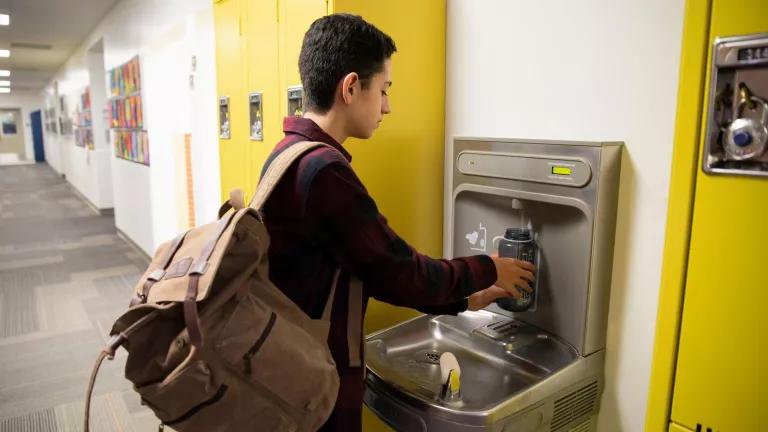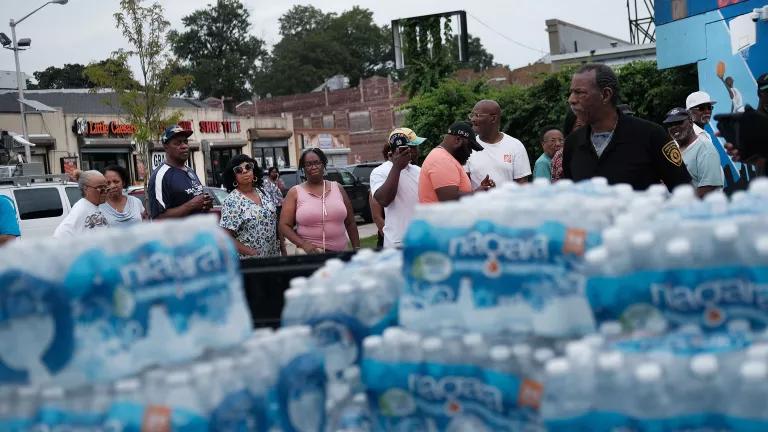Colorado Bill Will Protect Kids from Lead in Drinking Water
Representative Sirota, Senator Fields, and Senator Winter have introduced a bill that would get the lead out of drinking water in childcare centers and public schools by adding filters to drinking water taps.

Alamy
On Friday, Colorado took a big step to protect some of its smallest residents from lead exposure. Representative Sirota, Senator Fields, and Senator Winter have introduced a bill that would get the lead out of drinking water in childcare centers and public schools by adding filters to drinking water taps.
If passed, HB22- 1358 would do the following to protect our kids in the places where they spend thousands of hours of their young lives:
- Require schools and childcare centers to install filtered drinking water fountains and point of use filters in certain situations.
- Ensure that non-filtered outlets are not used for drinking or cooking.
- Provide drinking water to children that does not contain lead because no amount of lead is safe.
- Require schools and childcare centers to test the filtered tap water annually to ensure filters are functioning properly.
- Require schools and childcare centers to communicate with families about the quality of drinking water provided to children.
Why install filters?
Filters need to be installed because the sad fact is, if you test for lead, you will find it. State mandatory and voluntary testing programs have demonstrated this, from Colorado, New York, Indiana. It’s important to keep in mind that there is no safe level of lead in drinking water, and children are the most susceptible to the irreversible adverse effects of lead, which include the failure to concentrate, reduced cognitive ability, and aggressive behavior.
So, what have states found? About 82% of New York’s public schools had at least one test result above 15 parts per billion (ppb). In Indiana, about 62% of schools had at least one source that tested above 15 ppb. In Colorado, that figure was about 60%. If you look at results lower than 15 ppb, the number of schools exceeding those limits is far greater. This is very concerning and must be fixed, because the experts—including the Centers for Disease Control and Prevention (CDC), the American Academy of Pediatrics and the World Health Organization—all agree that there is no safe level of lead exposure.
These figures don’t even tell the complete picture. This is especially true in Colorado, where the state relied on voluntary testing and had extremely low participation (more on that later). Testing can also be inaccurate because of the variability of lead release-- test results at the same water source can vary dramatically from one water sample to another. This is in part because lead can be released in chunks, because of lead scale, and because lead levels can increase with the time that water has been sitting in contact with lead plumbing.
Filter First is quick and cost-effective.
Installing filters protects kids sooner than testing for and chasing the lead problem. Filtration stations take only a few hours to install, and faucet mount filters take minutes. These systems protect kids now. Repeated testing to attempt to identify all the leaded plumbing in a system, then removing and replacing those pipes and fixtures takes time and more money. Our cost analysis for Michigan’s Filter First bill demonstrates this. The Filter First program is cheaper in year one and in year ten; in the first year, we found savings of $26 million, and by year ten, it balloons to $331 million.
Why not replace the problematic plumbing?
There are at least two problems with plumbing replacements: 1) most school districts cannot make the immediate and large upfront investment necessary to replace all plumbing and fixtures necessary; and 2) the brand-new plumbing is problematic because even new fixtures, solder, and fittings are allowed to contain lead (even when labeled “lead-free!”). In contrast, we know filters work when they are certified to remove lead and when they’re installed and maintained properly.
What is Colorado doing now?
The Department of Public Health and the Environment will continue its voluntary testing program this year. A previous voluntary testing program ran from 2017-2020 and had very low participation, in large part because there was no money to fix any problems that became apparent through testing. The Filter First approach protects the health of children in schools and childcare centers; programs that simply test for lead in drinking water do not.
Only 67 schools participated in Colorado’s program over the three-year period, and even though the program “prioritized” disproportionately impacted communities, only three schools in these communities participated. Perhaps even more telling, less than 28% of available funds were expended over the life of the program. Understandably, when schools were faced with the difficult circumstance of discovering they had a lead problem but having no money or plan to fix it, most chose to not test.
Filter First offers a simple solution to the problem of lead in drinking water at our schools and childcare centers. It provides cleaner drinking water to our kids sooner, and in a more cost-effective way. It’s the best solution until we have truly lead-free plumbing. Our kids shouldn't have to wait any longer for clean water in their schools and childcare centers.




